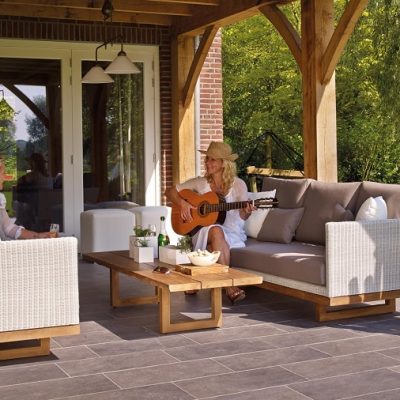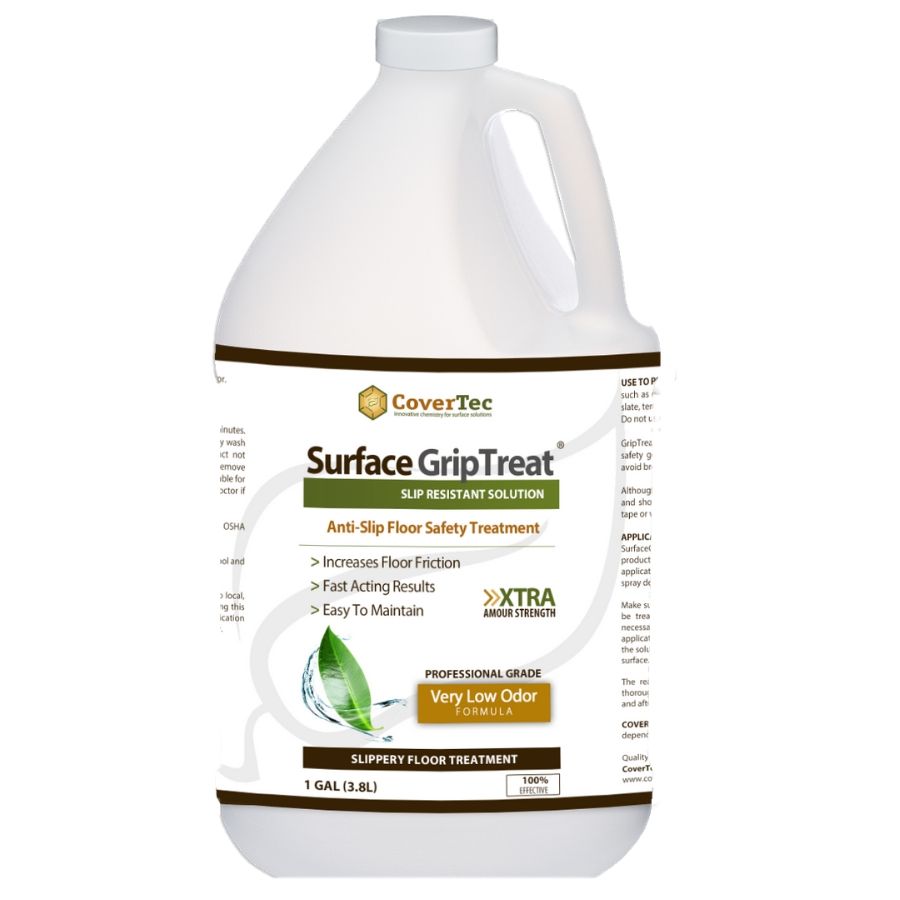This is a big application for CoverTec Products' sealers. Concrete itself is very absorbent, and…
How Do You Stop Pavers From Being Slippery
We get this question from customers calling our office every day. And even though customers’ environments vary, our responses are typically similar.
Our approach is very scientific. We measure the current slip resistance of a customer’s surface with the machine shown below.
Then we apply our professional grade sealers and anti-slip additives in the right amounts… ultimately producing a safe and attractive surface, whether it’s indoor or outdoors. Check it out below.
Details below. Click to go there now.
There are 3 methods you could use to stop pavers from being slippery.
- First, you could clean the paver every time you notice anything on the surface that could be slippery – if you had that kind of free time.
- Second, you could use a surface treatment to modify the slippery surface conditions.
- And third, you could use a sealer to increase the friction on the surface. All of these are useful solutions, and it all depends on your goal.
With the cleaning method, obviously you need to get the mold and mildew, food contaminants or water spills off the surface. This can be done by mopping to minimize the “slippery when wet” conditions. However, this is not always possible. This is when you need to look at the second option of using surface treatments.
Applying treatments on the surface of the paver should change its characteristics to manage water and greasy / oily solutions more effectively. The result being that when you walk or run on the surface – rather than aquaplaning – you have adequate traction to be safe.
The third option is to use sealers. And there are 2 basics types you need to be aware of:
If you choose to work with a Topical sealer, use one that contains an anti-slip additive that increases the friction on the surface. This will make it much harder for you to slip when moving across the surface. Otherwise, you can use a Penetrating sealer that soaks into the pavers’ pores and leaves the surface in a less slick or in a slippery condition.
This Device Measures Surface Slip Resistance With Precision.

Is Paver Sealer Slippery?
Paver sealer products can be slippery if applied too thick, leaving behind a slick film on the surface. Avoid this situation by using thin mil sealers that penetrate deep into the surface and leave a very thin film on the surface.
You can also use additives in the sealer itself to increase the friction on the surface. Again, you can always use a penetrating sealer that will soak into the sub-surface, without leaving a slippery film behind.
Key point:
We can scientifically measure how slippery a paver or tile surface is. Watch this video to see how we do this on a customer’s pool deck pavers – before and after – they use our pro-grade products.
What Are Typical Situations Where Non-Slip Paver Sealer Would Be Useful?
We always recommend applying an anti-slip sealer wherever your customers will be moving across your business premises. Whether your business is commercial, retail or involves consumers spending time at your location, you need to protect them from slip and fall risks.
Some examples include:
- Hotel entrances or exits (whether interior or exterior)
- Office buildings
- Restaurants
- Assisted living facilities
- Mall walking areas
- Food courts
- Public transportation areas
- Etc.


On pavers around or in the home, we stress the importance of using anti-slip sealers to make those surfaces less slippery and safe for everyone.
Some areas to pay special attention to are:
- Pool decks
- Driveways
- Walkways
- Patios
- Garage Floors
- Showers and bathrooms
- Etc.


Are Paver Sealers Non-Slip, Or Do You Need To Enhance Them?
It really depends on the type of sealer. Using a penetrating paver sealer, after soaking into the surface, they create a less slippery effect because they don’t leave a film on the surface. With that said, penetrating sealers don’t provide as much color enhancement or change in appearance.
If you’re interested in visual improvements to the paver and are considering topical sealers, be very selective. Some of these products can be slippery if applied too thick. In such cases, you can apply an anti-slip additive to the sealer to increase the traction and friction. The result is a much less slippery surface.
What Is A Non-Slip Additive For A Paver Sealer?
A non-slip additive is a powder-like grit or sand that is mixed into the sealer, or broadcasted into it while the surface is still wet.
Typical anti-slip additives are made from aluminum oxide, sand or polypropylene (a type of plastic or polycarbonate). And it’s important to note that each that of these additives have advantages and disadvantages.
The sand and aluminum oxide options are very hard-wearing. But you can often see them in a clear sealer. They’re also heavy enough to sink to the bottom of the sealer.
On top of this, they don’t get evenly dispersed if you’re mixing it into the sealer. Polypropylene is lightweight, but it’s not very hard-wearing and it can wear off very quickly.
Now polycarbonate – used in CoverTec’s CoverGrip anti-slip additive – offers the best of both worlds. It’s made from bulletproof glass. It’s impact-resistant and very hard-wearing.
Best of all, its lightweight structure lets it stay in suspension in your sealer.
So, what’s the benefit? When applying the sealer across the paver surface, the slip-resistant characteristics are also spread out as evenly as possible.
What Should You Look For In A Non-Slip Additive?
We recommend looking for two things in a non-slip additive.
1. First, make sure that it’s durable.
You need something that is hard-wearing, and will last in your sealer for many years.
2. Secondly, make sure that it’s not too heavy.
If the additive is too heavy, it will sink to the bottom of your mixing container, and it won’t be evenly distributed in your sealer as you roll it across the surface. If you’re broadcasting the additive, it’s less of an issue. However, most times customers prefer to mix the anti-slip additive into the sealer itself and then roll it out.
And as we stated above, Polypropylene, sand and aluminum oxide simply don’t satisfy both of the conditions we suggest above.
At CoverTec, we found polycarbonate to be the best product to use in our professional grade anti-slip additive and sealers. If you need to protect your surfaces against slip and fall liability, consider using any of our products shown below.
Conclusion
Stop “treading carefully” around your business or home. Increasing your floor’s slip-resistance or protection from slip and fall liability can be simple. It’s all about finding the right anti-slip product for the floor surface you are walking on.
As always, if you have any questions about which product is the best for your unique situation, call us at: 754-253-3401
Thanks for reading our blog post on how to increase the slip-resistance of your pavers – indoor and outdoor.
Bonus Video: Making a paver surface slip-resistant
Here’s a video showing how we helped a customer make their outdoor pool paver area much safer and slip-resistant for the family and friends.





